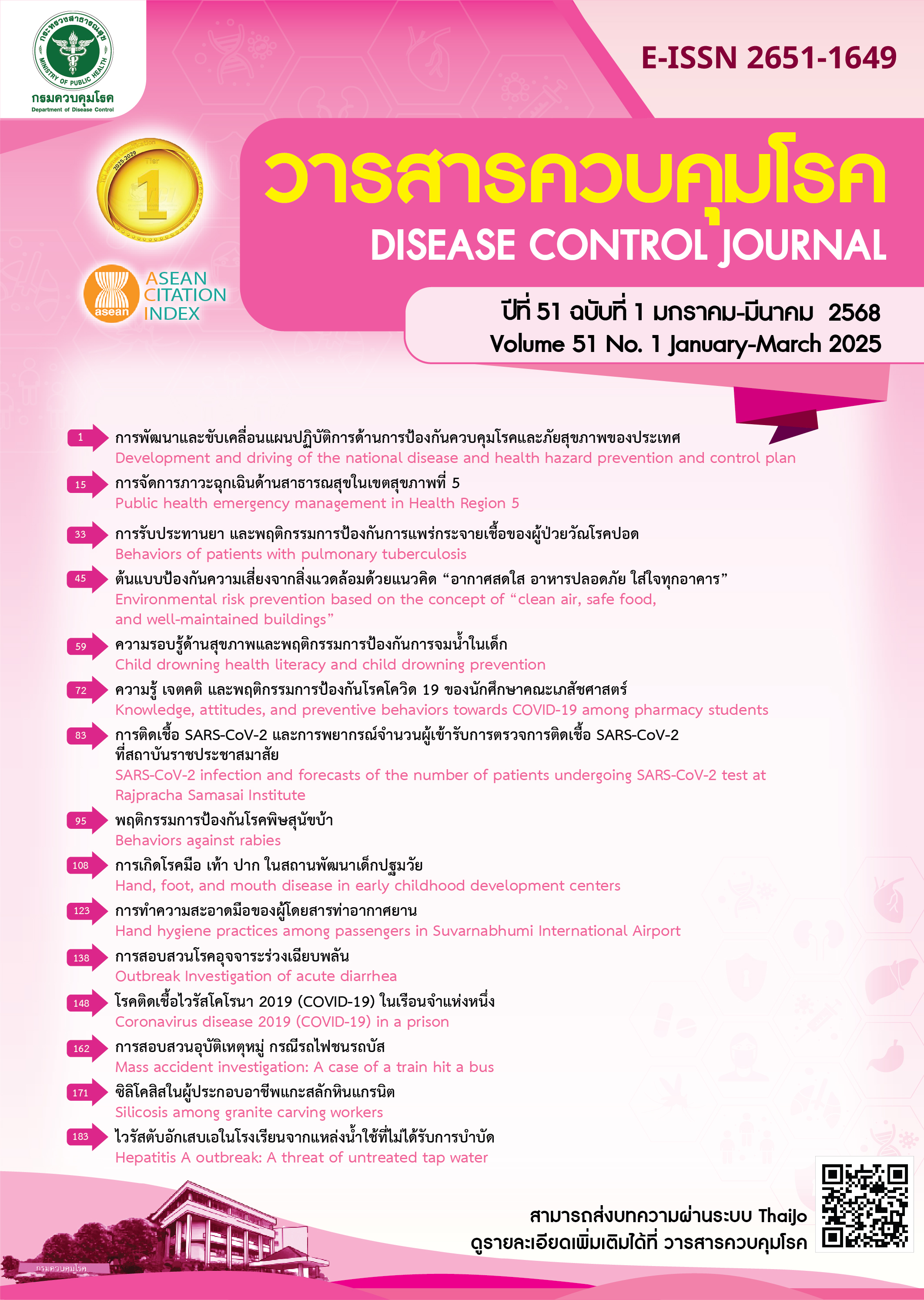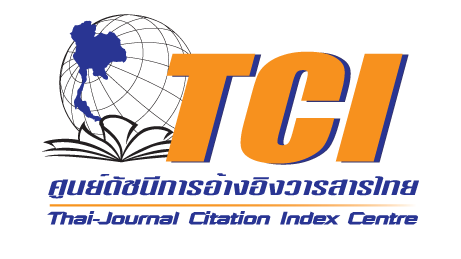An outbreak investigation of silicosis among granite carving workers in Wihan Daeng District, Saraburi Province
DOI:
https://doi.org/10.14456/dcj.2025.14Keywords:
silicosis, stone carving, Saraburi ProvinceAbstract
The Situational Awareness Team (SAT) of the Department of Disease Control was notified by the Office of Disease Prevention and Control Region 4, Saraburi, on November 18, 2022, that two patients diagnosed with silicosis were receiving treatment at Saraburi Hospital. The outbreak investigation was later conducted on November 22, 2022, to confirm the diagnosis, identify the causes of the disease, find additional cases, assess the work environment, and establish preventive measures for silicosis. The
investigation consists of descriptive epidemiological study by reviewing patient medical records at healthcare facilities, active case finding and walkthrough survey in the workplace, and measuring silica dust levels in the workplace environment by following the National Institute for Occupational Safety and Health (NIOSH) Methods No. 7601. Data analysis was conducted using descriptive statistics. Two confirmed cases were found from the investigation. Both patients have worked as stone carvers for over 20 years and usually they are not consistently using appropriate personal protective equipment (PPE) during work. The active case finding reveled five more patients from this workplace in the past five years, all of them have died. From the walkthrough survey, there were 10 people working in the same process as confirmed cases, who had been exposed to silica dust for over five years. Half of them developed symptoms, such as chest tightness and difficulty breathing. The walkthrough survey in the workplace demonstrated that the work process like stone carving has contributed to dispersion of silica dust as confirmed by a measurement of silica dust in workplace environment, with 6 out of 8 workplace environmental samples (75%) containing silica dust levels that exceed the standard limit. Additionally, not wearing or using PPE properly was one of the main risk factors contributing to this outbreak. Reducing the dust level by engineering control, e.g. by using specialized cutting or grinding tools, water curtain, and improving ventilation, was the proper recommendation for disease control measures in this setting. Moreover, workers should also be encouraged to consistently and properly use standard PPE to reduce the risk of developing silicosis. An annual health examination based on the risks should be conducted for detection of early stages of silicosis. Lastly, assessments of silica dust levels in the workplace should be performed regularly to ensure the safety of the workplace environment.
Downloads
References
Hoy RF, Chambers DC. Silica-related diseases in the modern world. Allergy Journal 2020; 11(75):2805-17.
Chansaengpetch S, Dumavibhat N, Kaewlai R, Jaroonpipatkul A, Virojskulchai T, Bunman S, et al. Underdiagnosis of silicosis revealed by reinterpretation of chest radiographs in Thai ceramic workers. MRM Journal 2023;18;910.
Ministry of Public Health (TH). Ministry of Public Health announcement: names or principal symptoms of occupational diseases or environmental diseases 2020. February 2021 [Internet]. [cited 2023 Apr 20]. Available from: https://ddc.moph.go.th/uploads/files/1132021 0203104425.PDF (in Thai)
Division of Occupational and Environmental Diseases, Department of Disease Control. Event-based 2018 Jan 1-2022 Dec 31. Nonthaburi: Division of Occupational and Environmental Diseases, Department of Disease Control (TH); 2023. (in Thai)
National Institute for Occupational Safety and Health. NIOSH Manual of Analytical Methods- 7601. March 2003 [Internet]. [cited 2023 Jun 12]. Available from: https://www.cdc.gov/niosh/docs/2003-154/pdfs/7601.pdf
Department of Disease Control (TH). Guidelines for surveillance and investigation of occupational diseases and environmental diseases under occupational diseases and environmental diseases control Act B.E.2562. 1. Nonthaburi: Department of Disease Control; 2023.
Ministry of Labor (TH), Department of Labour Protection and Welfare. Announcement of the Department of Labor Protection and Welfare: limits of Concentration of Hazardous Chemicals. August 2017 [Internet]. [cited 2023 Jul 10]. Available from: http://www.chemtrack.org/Law/MOLC-2560.pdf (in Thai)
American Conference of Governmental Industrial Hygienists (ACGIH) 2020 [Internet]. [cited 2023 Jan 12]. Available from: https://www.acgih.org/silica-crystalline-a-quartz-and-cristobalite/
Tiarnvipaswong T, Piromyu M. The study of health situation among workers exposed to silica dust in Thailand. Safety & Environment Review 2022;31(2):1-15.
Lukkanalikitkul E. Factors affecting of silicosis among stone grinding mill workers in Chonburi province. Dis Control J 2022;48(2):415-27.
Samana K, Ketsakorn A. Factors Associated with Preventive Health Behaviors Regarding Dust Exposure of Workers in Stone Crushing Mills in Saraburi. J Public Health 2019;49(2):234-48.
Khamlhom N, Somlak B, Sappaso B, Saisorn P, Sonpong A, Thippila J. Knowledge, attitudes and self-protection concrete dust behaviors among concrete casting workers in Mueangsrikai and Phoyai sub-district, Warinchamrap district, Ubonratchathani Province. OHSWA E-Journal 2022;5(1):35-42.
Fabiola S, Andrea M, Liviano V, Rosana B, Ottorino G, Gabriella G, et al. Occupational exposure to crystalline silica in artificial stone processing. J Occup Environ Hyg 2021;18(12):547-54.
Phookjit T, Praekunatham H, Buranasatitnon S, Dumavibhat N, Mitmark B, Pholprasert S, et al. An outbreak investigation of silicosis among sandstone carvers in Khok Samrong District, Lopburi Province, February 2021. Dis Control J 2023;49(4):858-70.
David LJ, Margaret LP, Anthony TV, Danielle AH, Chaolong Q. Experimental Evaluation of Respirable Dust and Crystalline Silica Controls During Simulated Performance of Stone Countertop Fabrication Tasks with Powered Hand Tools. Ann Work Expo Health. 2017;61(6):711-23.
Downloads
Published
How to Cite
Issue
Section
License
Copyright (c) 2025 Disease Control Journal

This work is licensed under a Creative Commons Attribution-NonCommercial-NoDerivatives 4.0 International License.
Articles published in the Disease Control Journal are considered as academic work, research or analysis of the personal opinion of the authors, not the opinion of the Thailand Department of Disease Control or editorial team. The authors must be responsible for their articles.


.png)



